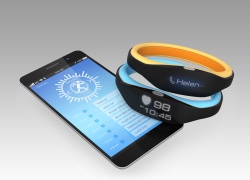
A digital wearable works wonders if you are a fitness geek and have a liking towards healthy living. Infact, wearables have truly revolutionized the healthcare industry. Gartner, in one of its healthcare reports, projects that by end of 2016 the wearable electronic device market will witness a sizeable sale of 274.6 million devices worth $28.7 billion.
Now what qualifies as wearable? In the words of PWC, wearable is defined as ‘Technology includes items, such as jewelry, glasses and clothing — worn on, in and around the body — incorporating sensors and other electronic technologies.’
The combination of sensors and wearables works phenomenal as it allows continuous monitoring of human physical data at regular intervals with minimum investment of cost. Lately, sensors are integrated in smart clothes, wristwatches, wristbands, eyeglasses and smartphones to deliver accurate healthcare statistics.
Sensors are considered the backbone for wearables. The working of sensor technology is the main contributor for connected health; providing us with fitness and health related analytics. They are excellent in mapping body fat composition, heart rate and temperature with slight contact with the human skin. Here are some stunning examples of how I can see wearables making a difference in our lives:
- Stickers with sensors – Wearable skin patches have introduced a new dimension to track body health statistics. A small patch of adhesive is required for them to function and synchronize data with your mobile phone. Since they are body type removable stickers, they can be worn under clothes and would not interfere with body movements, whether you are working out on the field or resting back at home. Then, there are nearly invisible disposable body tags that have sensors embedded and make use of iontophoresis to deliver medication without the use of a needle, painless!
- Fitness Trackers – The industry is flooding with fitness trackers infused with multiple sensors that offer extensive analytics in mapping fitness routines. Armed with BLE (Bluetooth Low Energy) technology, this wearable can be paired with a smartphone to have an engaging healthy lifestyle. Recent developments indicate the offering of a fitness coach as an added service along with the fitness tracker. Total footsteps in a day, distance travelled, time consumed for performing fitness activity, calorie consumption, sleep patterns, vibration enabled alarms and feedback mechanism are some of the features available in fitness trackers. A fitness tracker may not have call-connecting features as it only focuses on healthcare analytics.
- Epidermal Electronics – Implants are new in market and have a long way to go. These devices are surgically implanted in the human body to retrieve data. These implants are helpful in tracking blood flow which can trigger cardiac arrests or enable patients to know diabetic symptoms.
- Smartwatch – Smartwatches with particular programming of healthcare needs are growing multifold. A healthcare app can be easily installed in the smartphone and smartwatch, which can be paired over Bluetooth or Wi-Fi connectivity for alerts. A smartwatch can alert nurses in case of an emergency or for regular checkups when the patient is hospitalized. Patients strapped with a smartwatch have replaced the traditional call-bell system that is used in hospitals as it helps to increase the HCAHPS (Hospital Consumer Assessment for Healthcare Providers and Systems) ratings and ensures patient wellbeing.
Furthermore, sensors help in tracking physiological changes arising from chronic conditions by directly connecting the patient health activity with the doctor through a mobile application, further speeding recovery process.
In addition to above sensor enabled devices, wearable like pulse oximeters, ECG, blood pressure and glucose monitors worn close to the body have equally provided healthcare analytics to diagnose and monitor human health.
Connected health has the capabilities to offer healthcare services remotely. In addition, the healthcare ecosystem extensively relies on sensor technology to deliver accurate and in-depth results that can improve patient monitoring and enable a healthy lifestyle. The involvement of accelerometers, GPS, barometer, altimeter and gyroscopes has pushed wearables to deliver complex analytics in healthcare.
In the upcoming HIMSS 2016 conference, Harbinger Systems is participating as an exhibitor. The event is being held from February 29 to March 4, 2016 at Sands Expo and Convention Center, Las Vegas, Nevada. Meet us at booth #8450 to explore Harbinger’s forte in healthcare space.






